

SUSE SES 5.5 Real life deployment SUSECon19 - Nashville Florian Rommel, Datalounges Oy @datalounges https://www.datalounges.com
Welcome! (about us?)
About Us Who we are not: • The traditional run-off the mill IT company Who we are: • Cloud Gurus with a level of passion that is not very common • Excited about new things and extremely good at helping customers learn and embrace new tech • We work on things like Openstack, Ceph , Kubernetes, Nextcloud etc. (see the nice pictures in the footer??) and make them work for normal companies. • We work on one of the worlds largest Openstack deployments and own our own cloud • We have a lot of fun while working extreme hours to make the customers happy • If you cannot approach us with a challenge or a project and we cannot help you right away, it makes us try harder and come up with a solution that will make you and us happy
2 for 1 • We will go over 2 customer case studies • Deployment decisions were pretty much the same • Challenges were different and workloads were different
Why SUSE SES? • Ceph with management and promise of easy deployment • Licensing is flexible • Professional support • Local partners available for extreme cases
Case 1: Cinia Networks • Once upon a time in a hotel room, far far away..
Design and Decision making • Design was fairly simple and based on best practises with additional twists • Decision making was based on cost and offering as well as support and local specialist availbility • 2 Competing Solutions (vendors) • SUSE SES won out after we showed a real life deployment and helped with a misconfigured cluster they had
Deployment Initially deployed with SES 5 on vanilla hardware with bluestore • Design was initially all spindles, ( 2 NVMEs were available because • erronneous ordering) Pre-work was 0.5 man days • Deployment prep and discovery run took less than 30 minutes • Actual Deployment took less than 3 hours for all nodes, OSDs and • Monitors Service Availability for customer testing, 4 hours after initial start. •
Architecture
Pitfalls • SES 5.5 was released 3 days after deployment… • iSCSI Gateway was a ”requirement” and a stumbling block • S3 Gateway HA was misconfigured • NVME WAL/DB mishap
When it all worked… 40 hours, 4K Blocks, 200GB write 72 hours, 4MB Blocks, 200GB Sets sets
Case 2: Finnish Meteorological Institute (FMI)
Design and Decision making • Design was also relatively simple but became complex • Ceph cluster replication was required • Initial CE PH cluster was already present • Licensing was a big issue • Local E xpertise was needed (and still is)
Deployment: 1 Initially deployed with SES 4 on vanilla hardware with filestore • Upgrade to SES 5 went without a hitch but with service interruption and complexity • SES 5 was then migrated to Bluestore witho NO service interruption • Upgrade to SES 5.5 was performed as a rolling upgrade • Cluster Expansion went witout a hitch and only 25% of performance drop. Per OSD node replication • Each New node was brought in 1 by 1 due to workloads on the cluster • Total workload speed improvement was almost 3 times of SES 4. • RadosGW deployment was new with multi homed gateways running on 2 different networks on the same node •
Deployment: 2 • Due to nature of workload, Cluster had to be replicated • Feature not available at the time of design so it went async • Replication of data is a complext script that runs every 10 minutes to sync the data off to another location • Monitoring was an issue, especially Logs and error detection for both clusters in a single location
Pitfalls • SES 4 was not SALT based installation • Hardware failure during upgrade • Replication script needed a lot of work • Monitoring requirements needed a special solution
When it all worked… Total space went from 400TB to 800TB on each location • Throughput went up by about 40% • Access to RadosGW was available through https to partners • Ganesha NFS was avaialble for internal users (scentists) as well as • internal S3 Log analysis works in realtime with statistics and error alerting right away • based on location Things still ongoing especially with the replication and management •
Thank you for watching the show, questions? https://www.datalounges.com @datalounges
Recommend
More recommend